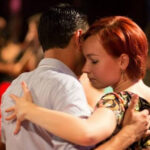“Dancing Queen,” a song synonymous with ABBA and arguably one of the greatest pop anthems ever created, wasn’t an overnight sensation. While its infectious melody and uplifting spirit quickly conquered the global charts upon release, the journey to its Dancing Queen Release Date was a fascinating tale of musical evolution, strategic decisions, and royal connections. Let’s delve into the story behind this masterpiece and explore the timeline leading up to its momentous arrival.
From Boogaloo to Ballroom: The Genesis of a Dance Classic
In the summer of 1975, following a successful Swedish tour, ABBA’s creative engine, Benny Andersson and Björn Ulvaeus, were already hard at work crafting new material. The pressure to follow up their international breakthrough with “Waterloo” was palpable, and the duo retreated to Glen Studios in a Stockholm suburb on August 4th. Accompanied by session musicians, they embarked on two days of recording instrumental tracks for three embryonic songs. At this stage, lyrics were mere placeholders, and titles were equally provisional.
One of these musical sketches, initially dubbed “Boogaloo,” hinted at its rhythmic nature. This early iteration was the seed that would blossom into “Dancing Queen.” Björn and Benny, aiming for a distinct dance feel, drew inspiration from George McCrae’s 1974 disco hit “Rock Your Baby,” a landmark track in the burgeoning disco genre. Further rhythmic nuances were gleaned from the drumming on Dr. John’s 1972 album “Gumbo,” a favorite of ABBA’s session drummer Roger Palm and engineer Michael B. Tretow.
The foundation of “Boogaloo” was laid with a robust backing track featuring drums, bass, guitar, and keyboards. Even in its nascent form, the instrumental track resonated deeply. Anni-Frid “Frida” Lyngstad, upon hearing a tape of this early version, was profoundly moved. “Benny came home with a tape of the backing track and played it for me,” she recalled. “I thought it was so enormously beautiful that I started to cry.”
Refining the Crown Jewel: The Production Journey
Despite the initial emotional impact, “Dancing Queen” was far from complete. It embarked on a somewhat protracted journey to its final form, a rarity for ABBA’s typically efficient recording process. Manager Stig Anderson played a crucial role, suggesting the title “Dancing Queen” and collaborating with Björn on the lyrics. By September 1975, Agnetha Fältskog and Frida had laid down their vocal tracks, adding the signature harmonies that define ABBA’s sound.
However, the meticulous duo of Björn and Benny continued to refine the recording, adding further overdubs as late as December 1975. This painstaking attention to detail underscores their commitment to sonic perfection and their intuition that “Dancing Queen” held exceptional potential.
The Royal Snub and the Anticipated Release
Interestingly, “Dancing Queen” and “Fernando,” another ABBA classic, reached completion around the same period. As March 1976 approached, ABBA faced a strategic dilemma: which song to release as their next single? Both tracks were recognized as having significant hit potential. Stig Anderson advocated for “Fernando,” believing a ballad would provide a refreshing contrast to their previous upbeat single, “Mamma Mia.” Björn and Benny ultimately concurred, and the dancing queen release date was deferred.
However, “Dancing Queen” wasn’t kept entirely under wraps. In January 1976, ABBA performed the song for a German television special, offering a tantalizing preview to European audiences. This was followed by another performance in March, filmed during their visit to Australia for the TV special “ABBA In Australia,” which was subsequently broadcast internationally.
Then came a truly unique and prestigious unveiling. On June 18, 1976, the eve of the wedding of King Carl XVI Gustaf of Sweden and Silvia Sommerlath, ABBA was invited to perform at a televised gala held at the Royal Swedish Opera in Stockholm. As Sweden’s premier pop act, they chose this grand occasion to introduce “Dancing Queen” to their home audience. Adorned in baroque-inspired outfits, a playful nod to the ceremonious atmosphere, ABBA presented their upcoming single to Swedish royalty and the nation.
Conquering the World: The Official Dancing Queen Release Date
Finally, on August 16, 1976, the official dancing queen release date arrived in Sweden. The single, backed by “That’s Me” from the “Arrival” album sessions, was released with a striking cover image of ABBA in white hats, captured by Ola Lager, a frequent collaborator on their album art. This photograph became one of the band’s most iconic and personally cherished images.
The release was accompanied by a promo video, directed by Lasse Hallström, filmed at Alexandra’s discotheque in Stockholm, a trendy hotspot at the time. The video and the song together created a perfect storm of pop culture impact.
“Dancing Queen” rapidly ascended to the top of charts worldwide, its joyous sound, marked by Benny’s signature piano melodies and Agnetha and Frida’s unmistakable vocal blend, resonating with audiences globally. In April 1977, it achieved ABBA’s first and only number one hit in the United States, solidifying its status as a global phenomenon.
“Dancing Queen” transcends its status as ABBA’s most celebrated song; it is universally recognized as one of the quintessential pop songs of all time. Even within ABBA, there was an immediate sense of its exceptional quality. Agnetha recalled, “It’s hard to tell when a hit is being made, you don’t always sense it. ‘Dancing Queen’ was an exception, we knew immediately it was going to be massive.” And massive it became, forever etching its dancing queen release date in pop music history.


